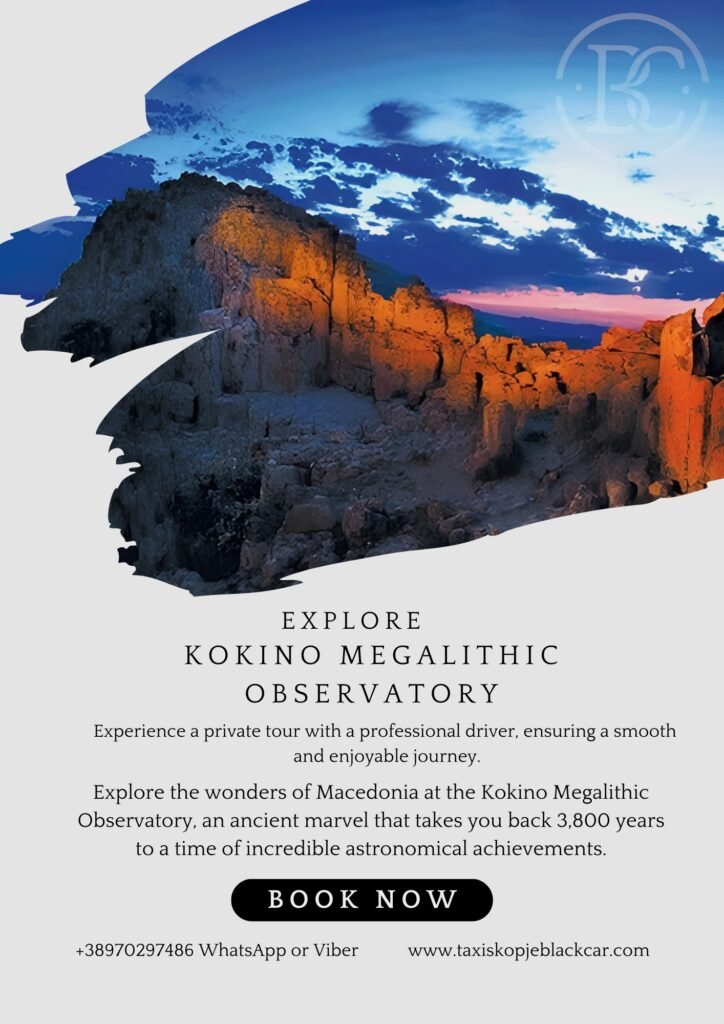🔭 Explore the Kokino Megalithic Observatory – Where History Meets the Stars! 🌌✨
Step into the past and uncover the secrets of Kokino, an ancient observatory dating back 3,800 years!
Recognized by NASA as one of the top 15 ancient observatories, this incredible site showcases the astronomical knowledge of early civilizations. 🪐🌞
Kokino Observatory is a significant cultural and historical site, often discussed as a potential candidate for UNESCO’s World Heritage List. 🌍✨
Perched high in the Macedonian mountains, Kokino offers breathtaking views, a rich history, and a deep connection to the cosmos. Join us on this unforgettable journey and witness the legacy of one of the world’s most fascinating ancient sites! 🌍🇲🇰

Travel in a sleek, black car, enjoying air conditioning, plush seating, and a professional driver dedicated to making your experience unforgettable. We’ve covered whether you’re looking for history, nature, or culture.
Kokino Day Trip – Private Tour with Driver 🚗
- 🌟 Explore Kokino in comfort and style with our full-day trip!
- Car – Only 99€
- Max 4 Passengers
- Our service includes:
- ✅ Professional driver
- ✅ Clean, comfortable vehicle
- ✅ Personalized itinerary
We’re available 24/7
✆ +38970297486 on Viber or WhatsApp
Kokino Day Trip takes you to an archaeo-astronomical site. The megalithic observatory “Kokino” is located in the northeastern part of the Republic of Macedonia. 19km to the northeast of the town of Kumanovo. Administratively, it belongs to the municipality of Staro Nagorichane. It comprises an area with a surface of 100m. In the direction east-west and 50m in the direction north-south, at the peak of the imposing rocky hill called Tatichev Kamen. It is at an elevation of 1013 m.
Kokino Day Trip takes you to a hill formed from volcanic rocks. It has a conical form with a saddle at the top, and it belongs to the volcanic area Kratovo-Zletovo. The volcanic cone, the lateral secondary parasite effusions. And the volcanic neck (petrified lava in the lower volcanic channel) is preserved from the extinct volcano. The erupted lava is intermediate with an andesitic composition, with clearly columnar (prismatic) emission and accentuated cracks.
All crucial features of the ancient observatory are situated on two platforms. An upper and a lower one, at an elevation difference of 19m. The shapes of four stone seats (“thrones”) placed in a row dominate the lower, western side. They are oriented in the direction north-south. Enabling the one sitting on the throne. To observe the apparitions on the upper platform, while the tops of the rocks played the role of an eastern horizon.
According to archaeo-astronomical analysis, the main role of the thrones was, in fact, to facilitate a bonding ritual between the Sun God and his earthly representative—the ruler. Specifically, the ruler would sit on the second throne during the ritual. Furthermore, supporting evidence for this practice can be found in a distinct stone block featuring a separate marker cutting on its top, which is strategically placed beneath the site’s highest elevation. Significantly, this ritual occurred in mid-summer—namely, on the last day of July—when the Sun rises in perfect alignment with the opening of the stone marker.
The day on which the rite was performed coincided with the end of the harvest season. Marking the conclusion of the annual cycle of the plants and, at the same time, the depletion of the ruler’s energy. However, by symbolically reuniting with the Sun God, through the sunlight that illuminated his face during the ritual. The ruler’s strength and divine power were renewed. This meant hope for a peaceful life for the community and rich crops in the year to come. Twenty hand grinders found in the proximity of the room at the base of the ritual mark are a testimony to the performance of the rite that marked the end of the harvest.
The central space of the ancient observatory was to the south-west from the thrones. It was used for observing the eastern horizon. All nine marker cuttings at the eastern horizon used by the ancient “astronomers” for daily marking of the rising of the Sun and the Moon can be seen from here. Three of the marker cuttings were intended to mark the rising of the Sun in the day of the summer solstice, the autumn and the spring equinox and the winter solstice.
The six remaining marker cuttings marked the spots of the rising of the full Moon on days when it had the smallest and biggest declination during winter and summer. The two marker cuttings that were used to measure the length of the lunar months can be seen here. They were utilized for the making of a calendar for a periodic cycle of 19 lunar years.
If you’d like to explore our most popular tours, be sure to check out the Skopje Full-Day Tours.
Our Partners – Growing Together
At Spaces Coworking Skopje, we believe that great work happens through collaboration — not just within our walls, but beyond them.